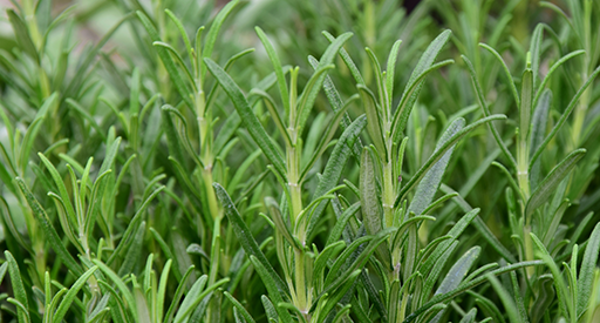
5 steps to Rosemary Growing Success
- Choose a sheltered, sunny spot close to your kitchen for easy access, or for your pots and containers.
- Prepare your soil well by mixing in organic matter like sheep pellets.
- Add a layer of garden mix to the planting hole.
- Feed rosemary in spring to promote green growth.
- Pick regularly to keep the plant compact and ensure plentiful sprigs for picking.
Follow our full guide below to a bumper crop of homegrown rosemary.
Traditionally, rosemary is a symbol of remembrance, fidelity and friendships. This hardy evergreen shrub is prized for its highly aromatic foliage and tolerance to neglect, not needing any special attention to flourish.
The perfect accompaniment for Mediterranean dishes, it's especially good with roast lamb or brushed with oil over focaccia bread.
PREPARE
Plant in a sunny sheltered position that gets at least six hours sunshine in the growing season. Light shade is ok as long as the soil is well drained as rosemary does not tolerate waterlogged soils.
A versatile plant, there are upright and prostrate growing varieties, perfect as a low growing hedge, spilling over banks and walls or for pots and containers. Rosemary comes in all shades of blue as well as pink.
Choose a rosemary variety to suit your garden space:
- Upright growing ‘Tuscan Blue’ has lovely blue flowers and is best for culinary use and ideal for a low growing, low maintenance hedges. Grows to a height of approximately 1.5m.
- Trailing ‘Prostrata’ is a hardy ground cover smothered in bright blue flowers in summer spreading 30cm x 1.5m.
- Compact growing slightly trailing ‘Chefs Choice’ has sparse flowers but is perfect for aromatic oils, roast potatoes or cooked with lamb, beef and chicken. Grows 60cm x 60cm.
PLANT
Rosemary is not typically grown from seed as germination is slow, but it can easily be grown from cuttings. Lightly prune after flowering has finished in summer to prevent the plant becoming ‘woody’. Plant rosemary at any time of the year, it is frost hardy and drought tolerant once established.
Planting in garden beds
- Choose a well drained sunny sheltered spot.
- Dig a hole twice the diameter of the original pot, and the same depth.
- Mix a handful of Tui Certified Organic Sheep Pellets into the planting hole, along with some Tui Garden Mix.
- Remove the plant from its pot, gently tease out the roots and place in the centre of the planting hole. Plant to a depth that is the same level as in the original pot.
- Use Garden Mix to back fill the planting hole, firm down as you go and water in well.
Cuttings can be taken from established rosemary plants, the best time to do this is spring and summer. Take a semi-hardwood tip cutting that is around 10-15cm long, pinch the tip, strip the lower leaves and place directly into garden soil in a sheltered spot where the cutting will be kept moist or into a pot filled with Tui Herb Mix (or Seed Raising Mix) place the cutting in a dappled shade area and keep moist.
Planting in pots & containers
- Choose a pot that is twice the diameter of the existing pot with drainage holes.
- Half fill the new pot with Tui Herb Mix.
- Remove the plant from its existing pot, gently tease the roots from the root ball and place in the centre of the new pot.
- Fill and firm with Herb mix to 3cm from the top of the pot to allow for watering in summer.
NOURISH
Harvest rosemary sprigs whenever required, regular picking will help keep the plant compact and ensure plentiful sprigs for picking.
Rosemary doesn’t need a lot of fertiliser, plants will benefit from a side dressing of Tui Novatec in spring and a handful of Tui Certified Organic Sheep Pellets in spring and autumn to help condition the soil.
Novatec can also be used on rosemary growing in pots and containers in spring, apply to the surface of the potting mix spreading evenly around the base of the plant and water in well.
Rosemary is not really troubled by insect pests and disease as long as it is planted in free draining soil in a sunny position. Heavy shade, poorly drained soils and high humidity can be problematic for rosemary.
Although rosemary can handle drier soil, plants will benefit from deep watering in extremely hot and dry periods. In summer add a light layer of Tui Mulch & Feed to help retain moisture and improve soil structure.
COMPANIONS
The aromatic foliage repels mosquitoes and protects brassicas from white cabbage butterfly. Planted together, sage and rosemary are beneficial to each other, improving flavour and strengthening growth. It is also a good companion for beans and a good deterrent for Carrot Rust fly in carrots.
Rosemary is not a good growing companion for potatoes, but they are great roasting companions!